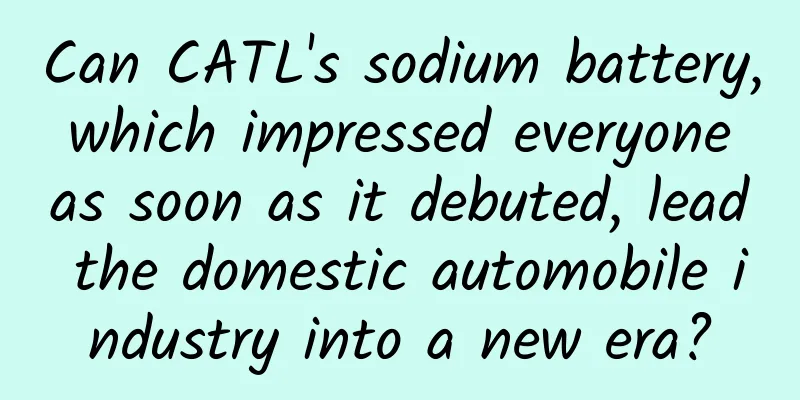Can CATL's sodium battery, which impressed everyone as soon as it debuted, lead the domestic automobile industry into a new era?

|
Battery technology has always severely restricted the development of the global smart car industry. However, with the launch of CATL's sodium battery, everything seems to be changing. Smart cars powered by batteries have very high requirements for battery performance. As a means of transportation, battery life has always been one of the parameters that consumers care about most, and consumers' driving scenarios are complex and diverse. This requires car companies to not only ensure that the battery's energy density is high enough, but also that the battery's discharge efficiency is strong enough in low-temperature environments. In addition, because smart cars have a direct impact on consumer safety, car companies also need to ensure that the batteries still have good safety performance when encountering extreme scenarios. With so many contradictions coming up, things seemed to be at a point where they were difficult to resolve. In fact, for many years, no battery has ever been able to perfectly meet these requirements of smart cars. Even though the sales of smart cars are currently rising, there are still many consumers who firmly refuse to buy smart cars because of reasons such as short battery life in winter and poor battery safety. Not long ago, CATL's world-first sodium battery technology may bring a glimmer of hope for progress in the current embarrassing situation of smart cars. Sodium batteries have obvious advantages, but it will take time to become popular In today's smart car power battery market, ternary lithium batteries and lithium iron phosphate batteries are definitely the mainstream of the market. According to market data in 2020, ternary lithium batteries accounted for 72.87% of the market and lithium iron phosphate batteries accounted for 22.93%. Although ternary lithium batteries and lithium iron phosphate batteries have a very high market share, this does not mean that their parameters have reached the extreme. Due to the characteristics of lithium materials, the discharge efficiency of both at low temperatures is significantly reduced compared to that at room temperature, which will significantly limit the availability of cars using these two batteries. The data of sodium batteries show that they will not encounter the same problems as lithium batteries. In a low temperature environment of -20℃, the discharge efficiency of sodium batteries can still be as high as 90%, while lithium iron phosphate batteries can only reach 54%, and ternary lithium batteries are slightly better, but can only reach 70%. This shows that the endurance performance of smart cars using sodium batteries in low temperature areas can be significantly better than that of models using ternary lithium batteries and lithium iron phosphate batteries. At the same time, not only is the discharge efficiency higher, the sodium battery launched by CATL also performs well in fast charging performance. According to the official data released at the press conference, the first generation of sodium batteries can be charged to 80% in 15 minutes. Such high discharge efficiency combined with fast charging can significantly improve the endurance performance of smart cars per unit time and greatly enhance the driving experience. In recent years, with the growth of smart car sales, safety has also received more attention from the public. Relevant data shows that from 2011 to 2019, there have been 127 explosion and fire accidents involving smart cars, of which pure electric models accounted for as high as 70%, and most of the incidents were caused by problems with the power battery. As for why power batteries can cause explosions and fires in smart cars, from a technical point of view, this is not because the battery quality is unqualified, but because manufacturers blindly increase the energy density of power batteries. Take the ternary lithium battery, which currently accounts for 72% of the market, as an example. Although its energy density is higher than that of lithium batteries using other technologies, the high energy density also means that it is more prone to thermal runaway problems when experiencing a collision, which in turn causes fires and explosions in smart cars. However, for car companies, in the context of the entire industry being engaged in a race for endurance, even though they know that the higher the battery energy density, the more likely it is to cause safety problems, if the energy density is not increased, the car's endurance in cold regions will be significantly reduced. Therefore, they can only go down one path and temporarily ignore the safety issue. Regarding this issue, in addition to the high discharge efficiency in low temperature environments mentioned above, sodium batteries are also safer than lithium batteries. This is because the chemical properties of sodium ions are more stable than lithium ions. Taking CATL's first-generation sodium battery as an example, it has passed the needle puncture, extrusion and overcharge and overdischarge tests perfectly, and also has good anti-spontaneous combustion and anti-explosion capabilities. Therefore, even with a high energy density, sodium batteries can be safer in the same collision scenario. Of course, as a first-generation product, sodium batteries also have obvious disadvantages. CATL's first-generation sodium batteries have a significant gap in energy density compared with ternary lithium batteries and lithium iron phosphate batteries. The energy density of the first-generation sodium batteries is only 160Wh/kg, while the latter two are 300Wh/kg and 200Wh/kg respectively. The biggest reason for this problem is that sodium ions are larger than lithium ions, so the energy density of sodium batteries is lower than that of lithium ions at the same volume. Although the current 160Wh/kg of the first-generation sodium batteries is sufficient for short-distance commuting in urban areas, once it involves long-distance driving, sodium batteries will definitely not be able to cope with it. Therefore, its current application limitations are still quite large. Not only that, as a product that has just begun commercialization, the production cost of sodium batteries in the short term is significantly higher than that of lithium iron phosphate batteries, and even higher than that of ternary lithium batteries. Therefore, it is still relatively difficult to achieve large-scale application in the short term, and it will still take a long time to achieve the popularization of sodium batteries. However, judging from the planning scheme released by CATL, the commercial prospects of sodium batteries are still relatively ideal. In terms of energy density, CATL has developed an integrated hybrid solution of lithium batteries and sodium batteries, which can integrate the advantages of sodium batteries and lithium batteries to provide a battery system that can still achieve efficient discharge at low temperatures and has high energy density, meeting the current commercial use needs of sodium batteries. In addition, CATL also revealed that the energy density of the second-generation sodium battery to be launched in the future will reach 200Wh/kg, which is the same as the current energy density of lithium iron phosphate batteries. As a result, the only obstacle for sodium batteries to achieve large-scale commercial use is the current high production costs. Sodium batteries help domestic smart car industry enter a new era It is obvious that the introduction of sodium batteries will have a significant impact on the power battery industry, and it can be predicted that the entire battery market will be reshuffled in the future. As the first commercial power battery pioneered by Chinese companies, what impact will sodium batteries have on my country's smart car industry? First of all, the large-scale commercialization of sodium batteries will also indicate that my country can gradually get rid of its dependence on lithium materials and improve the overall risk resistance of the industry. According to the 2020 USGS data, the current global lithium material reserves are concentrated in Chile, Australia and Argentina, accounting for 75% of the global share, while my country only accounts for 7.1%. At present, the production of lithium batteries basically relies on imported raw materials. In today's increasingly turbulent world situation, the high proportion of raw material imports is not a good signal. However, looking at the reserves of sodium raw materials, not only are the global total reserves 1,000 times that of lithium, but they are also evenly distributed across regions. my country's existing reserves alone can completely achieve self-sufficiency in sodium raw materials. Although in the short term, there is still a large gap in energy density between sodium batteries and lithium batteries, as long as we adhere to the strategy of developing sodium batteries and lithium batteries in parallel, it is foreseeable that we can get rid of "lithium dependence". It will also further enhance the independence and autonomy of my country's smart car industry and improve its resistance to foreign sanctions. From the current smart car leader Tesla's entry into China, it has triggered a sales frenzy by continuously lowering the prices of core components such as batteries due to the reduction in costs. It can be seen that most consumers will actively choose smart cars when buying cars as long as the price of smart cars has an advantage among cars of the same level. Therefore, the price factor has a great impact on the sales of smart cars, which is also the advantage of sodium batteries. Although the production cost of sodium batteries is relatively high in the short term, thanks to the current abundant global reserves and the advantage of being able to reuse lithium battery production lines, as production capacity expands, the production cost can be reduced to 30%~40% of lithium batteries. Therefore, as one of the components with the highest hardware cost in smart car production, the reduction in battery costs will also lead to a reduction in the price of the entire vehicle, thereby lowering the threshold for purchasing smart cars and promoting the popularization of smart cars. In addition, thanks to the unique advantages of sodium batteries, the use scenarios of smart cars have been further expanded. Because my country is geographically located across high latitudes and wide longitudes, the regional environment is quite complex, which means that smart cars cannot enter many extreme scenarios (such as severe cold and high temperatures) due to factors such as battery discharge efficiency and safety at high temperatures. Therefore, the potential market is not large. However, with the entry of sodium batteries with low-temperature, high-efficiency discharge and better safety, this long-standing problem can be solved, and the potential market for smart cars will also be able to achieve large-scale growth. For car companies, they can also create differentiated models for different purposes based on the different advantages and disadvantages of these three power batteries, enriching the types of smart car models. It can be said that sodium batteries fill the gaps in battery safety and availability at low temperatures for smart cars. As long as the energy density can be steadily improved and the production cost can be reduced, the popularization of sodium batteries will not be difficult. Overall, the sodium battery launched by CATL is indeed amazing. Although as a first-generation product, its energy density cannot reach the same level as lithium batteries, its safety and low-temperature durability data have clearly surpassed lithium batteries. The launch of sodium batteries also marks the gradual transformation of my country's smart car industry from "integration" to "innovation", establishing the scale advantage of smart cars, thereby forcing traditional car manufacturers to increase investment, thereby helping my country to quickly achieve the goal of overtaking Europe, the United States, Japan and South Korea in the era of smart cars. As a winner of Toutiao's Qingyun Plan and Baijiahao's Bai+ Plan, the 2019 Baidu Digital Author of the Year, the Baijiahao's Most Popular Author in the Technology Field, the 2019 Sogou Technology and Culture Author, and the 2021 Baijiahao Quarterly Influential Creator, he has won many awards, including the 2013 Sohu Best Industry Media Person, the 2015 China New Media Entrepreneurship Competition Beijing Third Place, the 2015 Guangmang Experience Award, the 2015 China New Media Entrepreneurship Competition Finals Third Place, and the 2018 Baidu Dynamic Annual Powerful Celebrity. |
Recommend
If the corals are gone, where will the crabs attach themselves to?
At present, global climate change, especially glo...
FirstCar.com: Top 10 pure electric sedans with the highest value retention rate in 2023 BYD Han EV has a one-year value retention rate of 70.66%, surpassing Tesla Model 3 to win the championship
Recently, the first car network announced the top...
Five awesome WeChat interactive marketing success cases, have you tried them all?
On January 21, 2015, the fourth birthday of WeCha...
How can education and training companies divert traffic from Douyin, Weibo, Himalaya, etc. to "private domain traffic" for conversion?
In this era of increasingly high traffic costs, i...
What is website promotion? How to promote a website?
What is website promotion : To put it simply, web...
Channel operation: How can newcomers do a good job in app store promotion?
1 What is channel operation promotion The term &q...
The world's largest video cloud ecosystem is emerging. LeEco Cloud has transformed after half a year of financing.
As the fourth LeEco sub-business to complete inde...
Why Surface Pro 3 is both loved and hated
Microsoft has released the third generation of Sur...
A watermelon costs 5 yuan, but the whole family is hospitalized for 5,400 yuan! How harmful is "overnight watermelon" to the body?
Interviewed expert: Wang Guoyi, Postdoctoral Fell...
3 tips to help operators write copy that attracts readers
Regarding copywriting , as an operator , I come i...
Samsung Electronics' share of the global DRAM market was 41.9% in the first half of 2023, down 1.6% year-on-year.
According to foreign media reports, due to the de...
What SEO strategies should startups adopt?
"The search rankings cannot rise as expected...
Zhang Ziyi and Gong Li's movie "Memoirs of a Geisha" HD Chinese subtitles
Based on the novel of the same name by American w...
Tesla, which knows more about autonomous driving than Mercedes-Benz, has announced the end of the era of internal combustion engines
In April this year, Tesla's stock price was a...
Google Play stops listing apps designed for older Android APIs
Google is very dissatisfied with the current situ...









